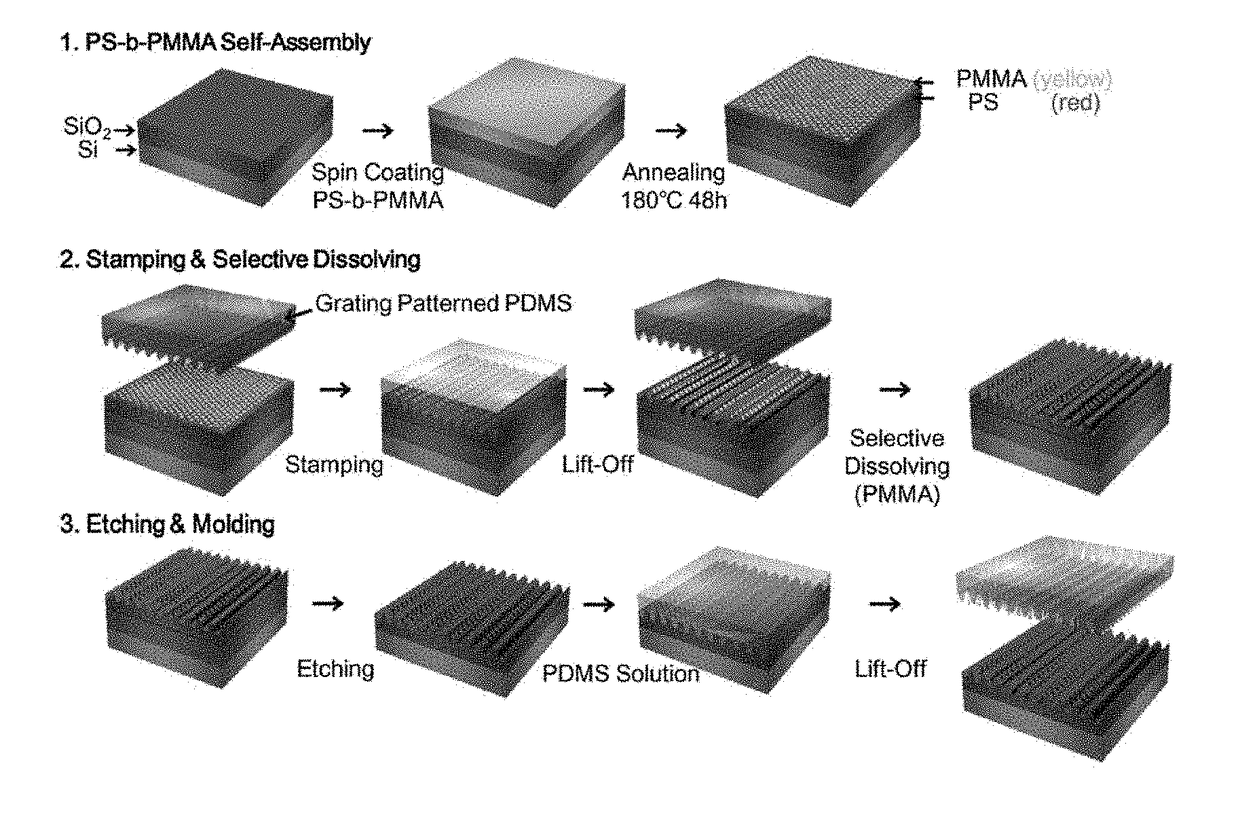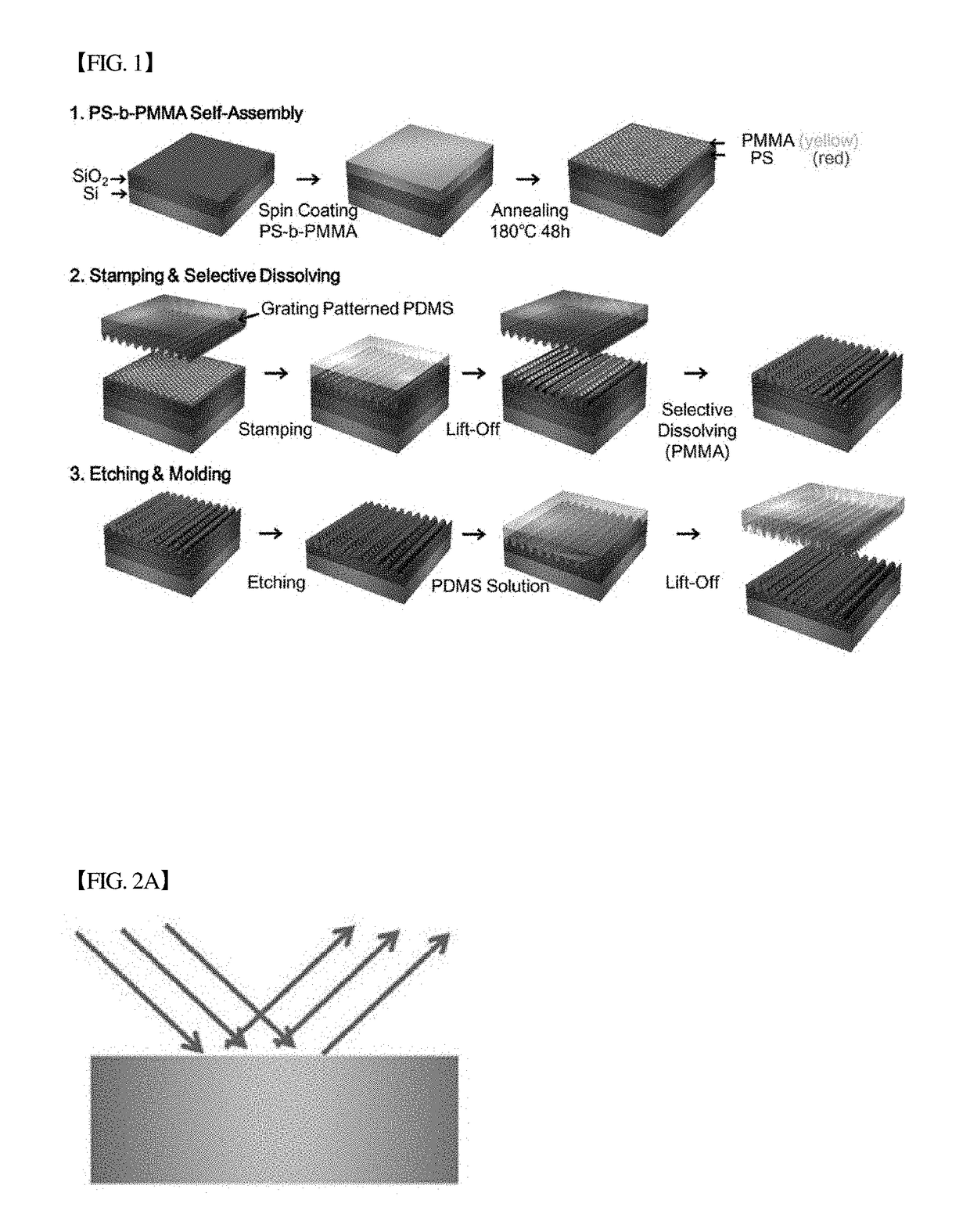Method of forming multiple nanopatterns and method of manufacturing organic solar cell using the same
a technology of organic solar cells and nano-patterns, applied in the field of multiple nano-patterns and a manufacturing method of organic solar cells, can solve the problems of increasing processing costs and achieve the effect of increasing light absorption efficiency and low cos
- Summary
- Abstract
- Description
- Claims
- Application Information
AI Technical Summary
Benefits of technology
Problems solved by technology
Method used
Image
Examples
preparation example 1
Nanopattern (Grating Pattern)
[0089]Polystyrene (Mn(PS)=192,000 g mol−1, Aldrich) was dissolved in an amount of 2 wt % in toluene to give a polystyrene solution, which was then applied through spin coating to a thickness of about 70 nm on a silicon wafer. Next, thermal treatment was conducted in a vacuum oven at 130° C. for 2 hr, thus forming a polystyrene layer. A polydimethylsiloxane (PDMS) precursor solution (comprising a curing agent and a silicon elastic polymer at a mass ratio of 1:10) was poured on a grating mold (Thorlabs, GH13-36U, Periodicity=278 nm) and cured at 60° C. for 2 hr, thus forming a nanoimprinting stamp. The nanoimprinting stamp was placed on the thermally treated polystyrene layer and pressure was applied at 130° C. for 10 min to thus transfer the grating nanopattern, thus preparing a grating-nanopatterned polystyrene layer.
[0090]Using the grating-nanopatterned polystyrene layer as a mask, reactive ion dry etching (RIE) (TTL Dielectric RIE, CF4 / CHF3 / O2 / Ar, flow...
preparation example 2
Pattern (Nanopost Pattern)
[0092]Polystyrene-block-polymethylmethacrylate (PS-b-PMMA, Mn(PS)=57,000 g mol−1, Mn(PMMA)=25,000 g mol−1, Mw / Mn<1.2, Aldrich) was dissolved in an amount of 2 wt % in toluene to give a block copolymer solution, which was then applied through spin coating to a thickness of about 70 nm on a silicon wafer. Next, thermal treatment was conducted in a vacuum oven at 180° C. for 48 hr, thus forming a phase-separated block copolymer layer. Subsequently, the phase-separated block copolymer layer was irradiated with UV light for 30 min and immersed in acetic acid for 20 min to selectively remove PMMA, thereby forming a nanopost-patterned polystyrene layer.
[0093]Thereafter, the preparation of a nanopost-patterned silicon wafer using the nanopost-patterned polystyrene layer as a mask and the preparation of a nanopost-patterned stamp using the nanopost-patterned silicon wafer were carried out in the same manner as in Preparation Example 1.
example 1
of Double Nanopattern (Multiple Patterns)
[0094]Polystyrene-block-polymethylmethacrylate (PS-b-PMMA, Mn(PS)=57,000 g mol−1, Mn(PMMA)=25,000 g mol−1, Mw / Mn<1.2, Aldrich) was dissolved in an amount of 2 wt % in toluene to give a block copolymer solution, which was then applied through spin coating to a thickness of about 70 nm on a silicon wafer. Next, thermal treatment was conducted in a vacuum oven at 180° C. for 48 hr, thus forming a phase-separated block copolymer layer. Subsequently, a polydimethylsiloxane (PDMS) precursor solution (comprising a curing agent and a silicon elastic polymer at a mass ratio of 1:10) was poured on a grating mold (Thorlabs, GH13-36U, Periodicity=278 nm) and cured at 60° C. for 2 hr, thus forming a nanoimprinting stamp. The nanoimprinting stamp was placed on the phase-separated block copolymer layer, and pressure was applied at 130° C. for 10 min to thus transfer the grating pattern, followed by UV irradiation for 30 min and then immersion in acetic acid...
PUM
 Login to View More
Login to View More Abstract
Description
Claims
Application Information
 Login to View More
Login to View More - R&D
- Intellectual Property
- Life Sciences
- Materials
- Tech Scout
- Unparalleled Data Quality
- Higher Quality Content
- 60% Fewer Hallucinations
Browse by: Latest US Patents, China's latest patents, Technical Efficacy Thesaurus, Application Domain, Technology Topic, Popular Technical Reports.
© 2025 PatSnap. All rights reserved.Legal|Privacy policy|Modern Slavery Act Transparency Statement|Sitemap|About US| Contact US: help@patsnap.com



